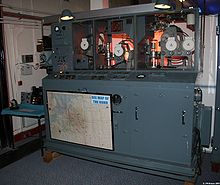


Gee, sometimes written GEE,[a] was a radio-navigation system used by the Royal Air Force during World War II. It measured the time delay between two radio signals to produce a fix, with accuracy on the order of a few hundred metres at ranges up to about 350 miles (560 km). It was the first hyperbolic navigation system to be used operationally, entering service with RAF Bomber Command in 1942.
Gee was devised by Robert Dippy as a short-range blind-landing system to improve safety during night operations. In the course of development by the Telecommunications Research Establishment (TRE) at Swanage, the range was found to be far better than expected. It then developed into a long-range, general navigation system. For large, fixed targets, such as cities that were attacked at night, Gee offered enough accuracy to be used as an aiming reference without the need to use a bombsight or other external references. Jamming reduced its usefulness as a bombing aid, but it remained in use as a navigational aid in the UK area throughout and after the war.
Gee remained an important part of the RAF's suite of navigation systems in the postwar era, and was included in aircraft such as the English Electric Canberra and the V-bomber fleet. It also had civilian use, and several new Gee chains were set up to support military and civil aviation across Europe. The system started to be shut down in the late 1960s, with the last station going off the air in 1970. Gee inspired the original LORAN ("Loran-A") system.
Cite error: There are <ref group=lower-alpha> tags or {{efn}} templates on this page, but the references will not show without a {{reflist|group=lower-alpha}} template or {{notelist}} template (see the help page).